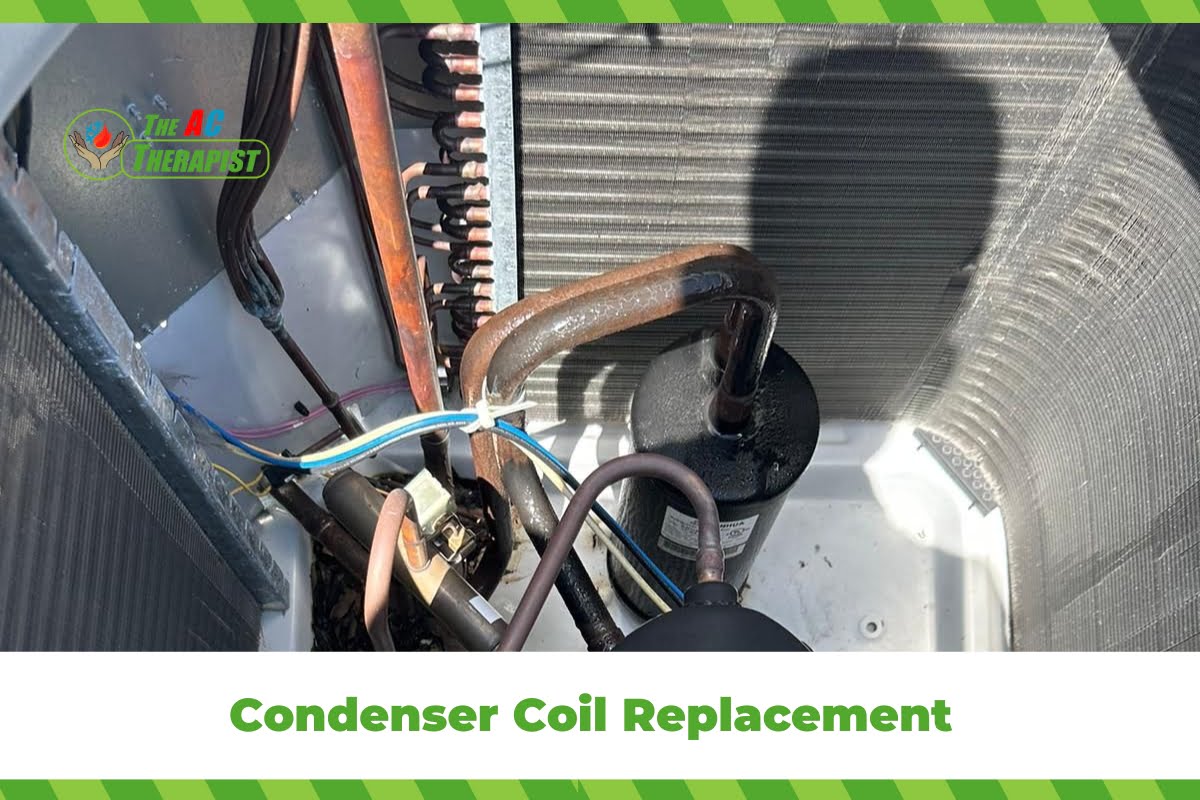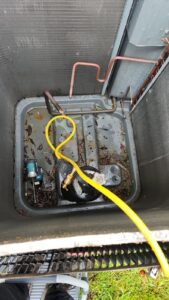Condenser Coil Replacement
When it comes to maintaining your HVAC system’s efficiency and extending its lifespan, one critical component to consider is the condenser coil. Condenser coil replacement might not be the most glamorous aspect of HVAC maintenance, but it’s an essential one. In this comprehensive guide, we will delve deep into the world of condenser coils, discussing why they matter, signs that it’s time for a replacement, the replacement process itself, cost considerations, and the long-term benefits you can expect.
Why Do Condenser Coils Matter?
Condenser coils are a critical component of your HVAC (Heating, Ventilation, and Air Conditioning) system, and they matter for several important reasons:
- Heat Dissipation: Condenser coils are responsible for releasing the heat that your HVAC system absorbs from your indoor space. During the cooling process, the refrigerant in the coils absorbs heat from inside your home and carries it to the outdoor unit, where the condenser coils release this heat into the surrounding air. Efficient heat dissipation is essential for maintaining a comfortable indoor temperature.
- Energy Efficiency: When condenser coils are clean and in good condition, they can efficiently release heat. However, if they become dirty, corroded, or damaged over time, their ability to dissipate heat decreases. This means your HVAC system has to work harder and longer to achieve the desired cooling effect, resulting in increased energy consumption and higher utility bills. In other words, well-maintained condenser coils contribute to better energy efficiency, which can save you money in the long run.
- Lifespan of Your HVAC System: HVAC systems are significant investments, and you want them to last as long as possible. Proper maintenance, including attention to condenser coils, can extend the lifespan of your system. Neglecting the condition of your coils can lead to more significant problems and costly repairs down the road, potentially shortening the life of your HVAC unit.
- Consistent Cooling Performance: Efficient condenser coils play a crucial role in maintaining consistent cooling performance throughout your home. If the coils are compromised, you might experience uneven cooling, with some rooms feeling too hot while others remain too cold. This can lead to discomfort and dissatisfaction with your HVAC system’s performance.
- Reduced Strain on the Compressor: The compressor is another vital component of your HVAC system. When condenser coils are functioning optimally, they help regulate the temperature of the refrigerant before it reaches the compressor. If the coils are not working properly, the compressor may have to work harder and endure more wear and tear, potentially leading to compressor failure and costly repairs.
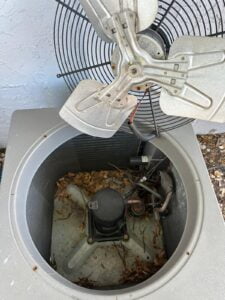
Signs That It’s Time for Condenser Coil Replacement
Recognizing the signs that it’s time for condenser coil replacement is crucial to maintaining the efficiency and performance of your HVAC (Heating, Ventilation, and Air Conditioning) system. Here are some common signs that indicate you may need to consider replacing the condenser coil:
- Reduced Cooling Efficiency: If you’ve noticed that your HVAC system isn’t cooling your home as effectively as it used to, this could be a sign that the condenser coil is no longer functioning optimally. Reduced cooling efficiency can result in discomfort and higher energy bills.
- Uneven Cooling: Inconsistent temperature distribution throughout your home can be indicative of a failing condenser coil. Some rooms might feel excessively warm, while others remain too cold, making it challenging to maintain a comfortable indoor environment.
- Increased Energy Bills: If your monthly energy bills have spiked unexpectedly, it’s a clear indication that your HVAC system is working harder to compensate for a compromised condenser coil. This increased energy consumption can strain your wallet.
- Noisy Operation: Unusual sounds coming from your outdoor HVAC unit, such as rattling, clanking, or squealing noises, can be a sign of a problem with the condenser coil or other components. Ignoring these noises may lead to more significant issues over time.
- Frequent Repairs: If you find yourself calling for HVAC repairs frequently, it may be an indication that your condenser coil is failing. Over time, the wear and tear on the coil can lead to recurring issues, and replacing it may be a more cost-effective solution than continuous repairs.
- Inefficient Cooling on Hot Days: On particularly hot days, if your HVAC system struggles to maintain a comfortable indoor temperature, it may be due to an inefficient condenser coil. Hot weather places additional demands on your cooling system, and a compromised coil may not be up to the task.
- Ice Buildup: If you notice ice forming on the outdoor unit, including the condenser coil itself, it’s a sign of potential problems. Ice buildup can impede the coil’s ability to release heat and may result from issues like refrigerant leaks or poor airflow.
- Visible Damage: Inspect your condenser coil for visible damage, such as corrosion, bent fins, or physical dents. Damage to the coil’s structure can impair its performance and warrant replacement.
- Age of the HVAC System: The age of your HVAC system can also be a factor. If your system is reaching the end of its expected lifespan and you’re experiencing performance issues, it might be a good time to consider a full system replacement, which would include a new condenser coil.
- Lack of Regular Maintenance: If you haven’t been diligent about regular HVAC maintenance, including cleaning and servicing the condenser coil, it’s more likely to deteriorate prematurely. Neglecting maintenance can lead to the need for replacement sooner than expected.
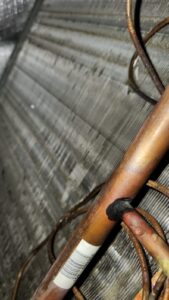
The Condenser Coil Replacement Process
The condenser coil replacement process is a crucial maintenance procedure for your HVAC (Heating, Ventilation, and Air Conditioning) system. It’s a task best left to experienced HVAC technicians due to its complexity and the need to handle refrigerants safely. Here’s an overview of the typical steps involved in the condenser coil replacement process:
1. Assessment:
- An HVAC technician will begin by assessing your HVAC system specifically the condenser coil. They’ll inspect the coil’s condition, looking for damage, corrosion, or any signs of wear and tear.
- The technician will also check for any other issues within the system that may need attention, such as refrigerant leaks or compressor problems.
2. Refrigerant Recovery:
- If replacement is deemed necessary, the technician will begin by recovering the refrigerant from the system. This involves safely removing and storing the refrigerant to prevent any environmental harm.
3. Coil Access:
- Access to the condenser coil is gained by removing the outer panel or cover of the outdoor unit. This provides the technician with a clear view of the coil and its connections.
4. Coil Removal:
- The old or damaged condenser coil is carefully removed from the outdoor unit. Great care is taken to prevent any damage to the surrounding components, such as the fan, compressor, and electrical connections.
5. New Coil Installation:
- The replacement condenser coil, which has been selected to match your HVAC system’s specifications, is installed in place of the old one. Proper positioning and secure attachment are essential to ensure optimal performance.
6. Refrigerant Lines and Connections:
- The refrigerant lines and connections are carefully reattached to the new coil. This includes ensuring proper soldering or brazing of copper lines to prevent refrigerant leaks.
7. Vacuum and Leak Test:
- The HVAC technician will vacuum the system to remove any remaining moisture and air, which can be harmful to the refrigerant and the system’s performance.
- A leak test is conducted to ensure that there are no refrigerant leaks in the newly installed coil or connections.
8. Refrigerant Recharge:
- Once the system is confirmed to be leak-free, the technician will recharge it with the appropriate amount of refrigerant. This is done according to the manufacturer’s specifications and takes into account factors such as the length of refrigerant lines.
9. Testing and Fine-Tuning:
- The HVAC system is thoroughly tested to ensure that it’s functioning correctly. This includes checking for proper cooling performance and ensuring that the system maintains the desired indoor temperature.
- Any necessary adjustments are made to fine-tune the system for optimal performance.
10. Cleanup: – The work area is cleaned up, and any debris or old parts are properly disposed of. – The outer panel or cover of the outdoor unit is securely reattached.
11. Final Inspection: – The HVAC technician will conduct a final inspection to ensure that all components are in good working order and that the condenser coil replacement has been successful.
12. System Startup: – The HVAC system is started up, and the technician monitors its performance to confirm that it’s operating as expected.
Once the condenser coil replacement process is complete, you can expect improved cooling efficiency and a more reliable HVAC system. Regular maintenance and timely replacement of components like condenser coils are essential for extending the lifespan of your HVAC system and optimizing its energy efficiency.
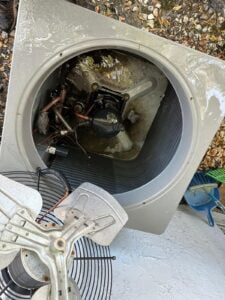
Cost Considerations for Condenser Coil Replacement
Cost considerations for condenser coil replacement can vary based on several factors. It’s essential to be aware of these factors when budgeting for this HVAC (Heating, Ventilation, and Air Conditioning) maintenance task. Here are the key factors that can influence the cost of condenser coil replacement:
- Type of Coil: The type of condenser coil you choose plays a significant role in the cost. Copper coils tend to be more expensive than aluminum coils, but they are known for their durability. Copper is an excellent conductor of heat and is less susceptible to corrosion.
- HVAC System Size: The size of your HVAC system impacts the cost of replacement. Larger HVAC systems typically require larger coils, which can be more expensive. Additionally, the labor required to install a coil in a larger system may be higher.
- Labor Costs: Labor costs can vary significantly depending on your location, the complexity of the job, and the HVAC contractor you choose. Labor typically includes the removal of the old coil, installation of the new coil, refrigerant handling, and system testing.
- Additional Repairs: If your HVAC system has other issues that need addressing, such as a malfunctioning compressor, fan motor, or refrigerant leaks, these repairs will add to the overall cost. It’s essential to address these issues to ensure the long-term performance of your HVAC system.
- Warranty Coverage: Check if your HVAC system or condenser coil is still under warranty. Some warranties may cover the cost of replacement components and labor. If your system is under warranty, this can significantly reduce your out-of-pocket expenses.
- Age of the HVAC System: If your HVAC system is older and nearing the end of its expected lifespan, you might need to consider a complete system replacement rather than just replacing the condenser coil. This can be a more significant upfront cost but may provide better long-term value.
- Contractor Quotes: It’s advisable to obtain quotes from multiple HVAC contractors. Different contractors may offer different pricing structures, and getting multiple quotes can help you make an informed decision.
- Location and Accessibility: The location of your outdoor HVAC unit can affect the cost. If it’s in a hard-to-reach area or requires additional work for accessibility, this can increase labor costs.
- Type of Refrigerant: The type of refrigerant used in your HVAC system can also impact the cost. Older systems that use R-22 refrigerant may be more expensive to recharge, as R-22 is being phased out and is becoming less available.
- Permits and Regulations: Depending on your local building codes and regulations, you may need permits for HVAC work, which can add to the overall cost.
The Long-Term Benefits of Condenser Coil Replacement
Condenser coil replacement may seem like a significant investment in your HVAC (Heating, Ventilation, and Air Conditioning) system, but it offers numerous long-term benefits that can make it a wise decision. Let’s explore these advantages:
- Improved Energy Efficiency: One of the most significant long-term benefits of condenser coil replacement is improved energy efficiency. When your new condenser coil operates optimally, it can dissipate heat more efficiently. This means your HVAC system won’t have to work as hard to cool your home, resulting in lower energy consumption and reduced utility bills over time.
- Enhanced Cooling Performance: A new condenser coil can significantly enhance your HVAC system’s cooling performance. You’ll experience consistent and reliable cooling throughout your home, ensuring comfort during hot summer months and reducing temperature fluctuations.
- Extended System Lifespan: Proper maintenance, including condenser coil replacement when necessary, can extend the lifespan of your HVAC system. By addressing issues promptly, you reduce the risk of major breakdowns and extend the overall longevity of your system. This can save you money on premature system replacements.
- Reduced Repairs: Old, damaged, or inefficient condenser coils can lead to frequent HVAC system breakdowns and the need for costly repairs. With a new condenser coil, you’re less likely to experience these issues, resulting in fewer repair expenses and less inconvenience.
- Environmental Benefits: An efficient HVAC system consumes less energy, which is not only cost-effective but also environmentally friendly. Reduced energy consumption leads to a smaller carbon footprint and contributes to a more sustainable and eco-friendly lifestyle.
- Consistent Comfort: A well-maintained HVAC system, with a properly functioning condenser coil, ensures consistent indoor comfort. You won’t have to endure uncomfortable temperature variations or hot spots in your home.
- Lower Operating Costs: While there’s an upfront cost associated with condenser coil replacement, the long-term operating costs of your HVAC system are likely to decrease. You’ll save money on energy bills, repair costs, and potentially on refrigerant, as an efficient system is less likely to experience refrigerant leaks.
- Peace of Mind: Knowing that your HVAC system is in top condition and less likely to fail provides peace of mind. You can rely on your system to keep your home comfortable year-round without unexpected breakdowns or emergency repairs.
- Compliance with Regulations: In some regions, there may be regulations regarding HVAC system efficiency. Upgrading your condenser coil to a more efficient model can ensure that your system complies with these regulations, avoiding potential fines or penalties.
- Home Value: A well-maintained and efficient HVAC system, including a recently replaced condenser coil, can enhance the resale value of your home. Potential buyers are often willing to pay more for homes with efficient and reliable heating and cooling systems.
Sealing the Deal on Comfort and Efficiency: The AC Therapist’s Take on Condenser Coil Replacement
At The AC Therapist, we wholeheartedly emphasize the significance of condenser coil replacement as a fundamental aspect of HVAC maintenance. It’s not just another task; it’s a wise investment in your long-term comfort and the overall efficiency of your air conditioning system.
First and foremost, when you opt for condenser coil replacement, you’re making a substantial commitment to energy efficiency. Our experience has shown that by allowing your system to dissipate heat more efficiently, you reduce the workload on your HVAC unit. This translates to lower energy consumption and reduced utility costs in the months and years to come.
But it’s not just about saving on bills; it’s also about ensuring consistent cooling performance throughout your living spaces. We know firsthand that there’s nothing more frustrating than battling temperature variations in your own home. A new condenser coil can put an end to these discomforts.
Moreover, the benefits extend to the lifespan of your HVAC system. We’ve witnessed how timely maintenance, including condenser coil replacement, can dramatically lower the risk of major breakdowns. This is a financial lifeline, saving you from the stress of premature system replacements.
By addressing issues proactively, you also minimize disruptions and lower repair costs. Old or inefficient condenser coils can lead to frequent system breakdowns, resulting in the need for costly repairs. With a new coil, your HVAC system is less likely to experience these issues.
Our commitment to the environment goes hand in hand with our services. An efficient HVAC system is not only cost-effective but also environmentally friendly. Reduced energy consumption means a smaller carbon footprint, contributing to a more sustainable future.
In essence, condenser coil replacement is a wise investment that enhances your comfort, cuts down on expenses, and promotes the longevity of your HVAC system. We encourage you to reach out to our team of experts at The AC Therapist to assess your system’s needs and unlock the full range of benefits associated with a well-maintained and efficient cooling system. Your comfort and satisfaction are our top priorities.

